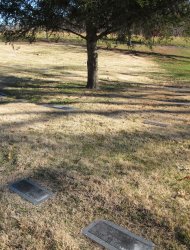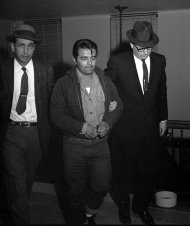At the end of 1959, two families of four — one in Kansas, the other in Florida — were brutally murdered.
Two men were arrested, charged
and executed in the Kansas case, and writer Truman Capote captured the
horrific tale in his iconic true crime book, "In Cold Blood."
The Florida murder of two parents and two children was investigated
by dozens of detectives over the years, but it remained unsolved. Now, a
detective is trying to prove that the men who were executed in Kansas
were also responsible for the Florida slayings.
"It's like putting together a
jigsaw puzzle," said Sarasota County Sheriff's detective Kimberly
McGath, who began re-investigating the murders of Cliff and Christine Walker and their two young children in 2007.
 McGath said there is evidence that points to two men who are now in a Kansas cemetery for executed prisoners: Perry Smith and Richard Hickock.
McGath said there is evidence that points to two men who are now in a Kansas cemetery for executed prisoners: Perry Smith and Richard Hickock.
Linking long-dead killers to unsolved homicides is becoming more common.
In Chicago, the Cook County
Sheriff's Department is trying to find out whether serial killer John
Wayne Gacy could be responsible for any more deaths. Officials there are
entering murderers' DNA profiles into a national database shared with
other law-enforcement agencies. The move is based on an ironic legal
distinction: The men were technically listed as homicide victims
themselves because they were put to death by the state.
 Authorities hope to find DNA matches from blood, semen, hair or skin
under victims' fingernails that link the long-dead killers to the
coldest of cold cases. And they want investigators in other states to
follow suit and submit the DNA of their own executed inmates or from
decades-old crime scenes.
Authorities hope to find DNA matches from blood, semen, hair or skin
under victims' fingernails that link the long-dead killers to the
coldest of cold cases. And they want investigators in other states to
follow suit and submit the DNA of their own executed inmates or from
decades-old crime scenes.Kansas officials said this week they have talked with Florida detectives and would continue to help if the Florida detectives file an exhumation petition in court.
Hickock and Smith are buried on a gently sloping hill at the Mount Muncie Cemetery in Lansing, Kan.
The state of Kansas interred its executed criminals there when their
families didn't claim the bodies. There are about 28,000 graves.
Cemetery manager Gene Kirby said the Hickock and Smith graves
regularly draw visitors, particularly around the anniversary of the
Clutter slayings or when "In Cold Blood" receives media attention.
"We have a fair amount of people
come out and ask where they're buried, want to come down and actually
see the graves," Kirby said. "If there's anything in the news that kind
of piques the interest."
The possibility that the pair was involved in the Florida murderers
has been considered since 1960, according to records released by the
Sarasota Sheriff's Office.After Smith and Hickock killed the Clutter family in Holcomb, Kan., on Nov. 15, 1959, they fled to Florida in a stolen car. They were spotted at least a dozen times from Tallahassee to Miami and points in between.
On Dec. 18, the two men checked
into a Miami Beach motel and checked out the next day. That day, the
Walker family was killed at their home on a ranch in the small community
of Osprey about four hours northwest of Miami near Sarasota.
Cliff Walker
was shot to death and his wife was beaten, raped and then shot.
Three-year-old Jimmie was shot to death and his 2-year-old sister was
shot and drowned in a bathtub. The gruesome scene days before Christmas
shocked investigators. News stories at the time noted that there were
gifts around the tree.
At some point on the same day, Smith and Hickock bought items at a
Sarasota department store. On Dec. 21, witnesses say they spoke with
Smith and Hickock in Tallahassee.McGath said the Walkers had been considering buying a 1956 Chevy Bel Air, which was the kind of car Smith and Hickock had stolen and were driving through Florida. McGath thinks that somehow, the Walkers and the killers met because of the car.
The detective found witness
statements — and talked to people who are still alive — who said they
saw Smith and Hickock in the Sarasota area around the time of the Walker
murders. One witness said the taller of the two men had a scratched-up
face.
The pair was later arrested in Las Vegas and a polygraph test cleared
them of the Walker murders. But in 1987, a polygraph expert said those
tests in the early 1960s were worthless.Authorities said the Walkers still have some living relatives both in and outside of Florida but declined to give names. McGath has been the one leading the effort to find their killers.
She hopes the DNA will prove that
Smith and Hickock killed the Walker family so the community can have
closure, and so the dozens of people falsely accused over the years as
suspects in the case can finally have peace of mind.
Kirby said it's likely that only bones remain in the Kansas coffins.
"In this case, it's going to
require a backhoe," he said. "Especially with the drought we had this
year, the ground is going to be extremely hard."
Kirby hopes that if an exhumation
occurs, officials will be able to get the material they need by simply
opening the coffin on site, without full removal. He was also concerned
about the timing of any exhumation, because relatives visit other graves
and decorate them around Christmas.

No comments:
Post a Comment